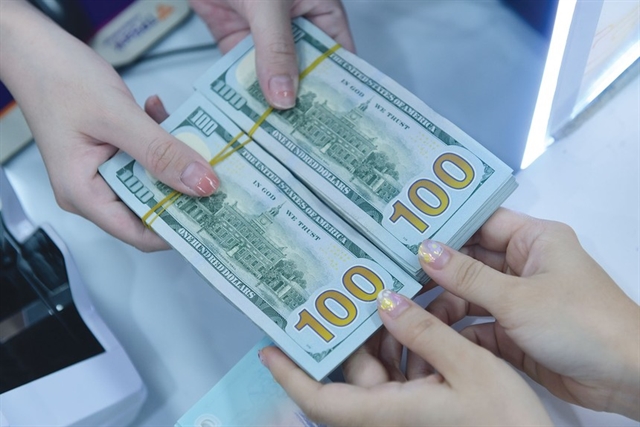Exchange Rate Prediction and Alerts
Exchange rate trends of Vietnamese Dong against US Dollar over the past 10 years:
- 2014: 1 USD ≈ 21,246 VND
- 2015: 1 USD ≈ 22,485 VND
- 2016: 1 USD ≈ 22,761 VND
- 2017: 1 USD ≈ 22,698 VND
- 2018: 1 USD ≈ 23,245 VND
- 2019: 1 USD ≈ 23,173 VND
- 2020: 1 USD ≈ 23,126 VND
- 2021: 1 USD ≈ 22,936 VND
- 2022: 1 USD ≈ 23,145 VND
- 2023: 1 USD ≈ 24,000 VND
- Early 2024: 1 USD ≈ 24,200 VND
Observations:
From 2014 to 2018, the Vietnamese Dong experienced a noticeable depreciation process. Between 2018 and 2021, the exchange rate was relatively stable, even showing a slight appreciation. Starting from 2022, Vietnam again showed a depreciation trend.
Annual Analysis:
Average annual fluctuation range is about 2-3%. The largest single-year depreciation occurred in 2015, approximately 5.8%. A slight appreciation of about 0.9% occurred in 2021.
Main Factors Affecting Vietnam’s Exchange Rate (In-depth Analysis)
Economic Growth: 2023 projected growth, 5.0-5.5% Strong economic growth typically supports currency value, but overheating may trigger panic. 2021 GDP growth 2.58%. 2022 GDP growth 8.02%.
Inflation: 2021 inflation rate,1.84%. 2022 inflation rate, 3.15%. 2023 target, control within 4.5% Moderate inflation is beneficial for currency stability, but attention needs to be paid to rising inflation.
Inflation: 2021 inflation rate: 1.84%; 2022 inflation rate: 3.15%; 2023 target: control within 4.5% Moderate inflation is beneficial for currency stability, but attention needs to be paid to rising inflation.
Trade Balance: 2021 trade surplus: $4 billion; 2022 trade surplus: $11.2 billion Continuous trade surpluses provide support for Vietnam, but global demand changes need to be monitored.
Foreign Exchange Reserves: End of 2021: approximately $110 billion; End of 2022: approximately $115 billion Sufficient foreign exchange reserves enhance Vietnam’s ability to cope with external shocks.
Government Policies: The State Bank of Vietnam (SBV) adopts a managed floating exchange rate system. Allows exchange rate fluctuations within a certain range (usually ±3%) This policy helps maintain exchange rate stability but may affect the degree of market freedom.
Global Economic Environment: Fed interest rate policy: The rapid rate hike cycle in 2022-2023 put pressure on emerging market currencies; US-China trade relations: Vietnam benefits from supply chain restructuring, attracting more foreign direct investment; Global inflation trends: Rising global inflation in 2022-2023 affects monetary policies of various countries.
Foreign Direct Investment (FDI): 2022 actual FDI inflow, approximately $22.5 billion, a 13.5% year-on-year increase FDI inflows help support Vietnam, but attention needs to be paid to the stability of capital flows.
Short-term, Medium-term, and Long-term Exchange Rate Forecasts
Short-term Forecast (3-6 months): Baseline forecast: 1 USD = 24,300-24,600 VND; Optimistic scenario: 1 USD = 24,000-24,300 VND (if inflation meets targets, export performance is strong); Pessimistic scenario: 1 USD = 24,600-25,000 VND (if global economic growth slows, external demand weakens).
Influencing Factors: Fed interest rate policy; Vietnam’s Q2 GDP growth data, Global commodity price trends.
Medium-term Forecast (6-12 months): Baseline forecast: 1 USD = 24,200-24,800 VND; Optimistic scenario: 1 USD = 23,800-24,200 VND (if global economy recovers, Vietnam’s export growth is strong); Pessimistic scenario: 1 USD = 24,800-25,300 VND (if inflation rises, exceeding targets).
Influencing Factors: Vietnamese government’s economic stimulus policies, Progress in US-China trade relations, Implementation effects of regional trade agreements (e.g., RCEP).
Long-term Forecast (1-2 years):
- Baseline forecast: 1 USD = 24,500-25,200 VND.
- Optimistic scenario: 1 USD = 24,000-24,500 VND (if structural reforms succeed, productivity significantly improves).
- Pessimistic scenario: 1 USD = 25,200-26,000 VND (if global economic uncertainty increases, trade barriers strengthen).
Influencing Factors: Impact of climate change and environmental policies on the economy, Vietnam’s industrial upgrade and economic transformation process. Global geopolitical developments.
Setting Exchange Rate Alerts
Short-term Key Points: Breaking 24,600 VND/USD: May trigger stop-loss or investment strategy adjustment. Falling below 24,200 VND/USD: Consider increasing allocation to Vietnamese assets.
Medium-term Key Points: Sustaining 24,800 VND/USD for 3 trading days: Potential formation of depreciation trend. Consistently below 24,000 VND/USD for a week: Evaluate the sustainability of VND appreciation.
Long-term Key Points: Quarterly average rate exceeding 25,200 VND/USD: Reassess long-term investment strategy. Maintaining below 24,500 VND/USD for half a year: Consider increasing long-term investments in Vietnam.
Volatility Alerts: Intraday fluctuation exceeding 1%: Closely monitor market news and central bank actions. Weekly fluctuation exceeding 2%: Assess need for adjusting currency exposure.
Trend Alerts: Breaking 2-year high or low: Potential formation of new long-term trend. Consistent unidirectional movement for 3 consecutive months: Analyze reasons for trend formation and sustainability.
Advanced Methods for Implementing Exchange Rate Alerts
Professional Forex Platforms: Use platforms like MetaTrader 4/5 to set complex conditional alerts. Can combine technical indicators (e.g., moving averages, RSI) to set alerts.
API Integration: Use forex APIs (e.g., Alpha Vantage, Fixer.io) to obtain real-time exchange rate data. Write custom programs combining multiple data sources and indicators for analysis and alerts.
Machine Learning Models: Use historical data to train prediction models, Issue alerts when actual exchange rates deviate from predicted values beyond specific thresholds.
Social Media Monitoring: Set up keyword monitoring for Vietnam economy-related discussions on platforms like Twitter, LinkedIn. Issue alerts when discussion intensity suddenly increases.
Calendar Integration: Set more frequent exchange rate checks before and after key data releases;Focus on important economic data releases affecting Vietnam (e.g., GDP, CPI, trade data).
Risk Management and Hedging Strategies
Forward Foreign Exchange Contracts: Suitable for businesses with fixed future foreign exchange needs. Lock in future exchange rates, reducing exchange rate volatility.
Foreign Exchange Options: Provide more flexible protection but at a higher cost. Can set different strike prices based on risk appetite.
Currency Swaps: Suitable for businesses with long-term recurring currency needs. Can lock in long-term exchange rates, reducing long-term exchange rate risk.
Natural Hedging: Balance foreign currency income and expenditure. Establish active entities in Vietnam, increasing local cost expenditure.
Diversification: Reduce dependence on a single currency pair, Use multiple currencies for international trade and investment.
Industry-Specific Considerations
Manufacturing: Focus on import costs of raw materials and export product pricing, Consider exchange rate adjustment clauses in long-term contracts.
Tourism: Monitor the impact of exchange rates on tourism. Consider dynamic pricing strategies reflecting exchange rate changes.
Real Estate: Focus on the impact of exchange rates on attractiveness to foreign investors. Consider offering multi-currency payment options.
Tech Startups: Consider using digital currencies or stablecoins for international transactions. Monitor the impact of exchange rates on international financing.
Macroeconomic Indicators
In addition to direct exchange rate data, the following indicators should be monitored: Industrial Production Index; Retail Sales Data; Foreign Direct Investment (FDI) Inflows; Consumer Confidence Index; Manufacturing Purchasing Managers’ Index (PMI). These indicators can predict economic trends in advance, thereby influencing exchange rate trends.
Regular Review and Adjustment: Monthly Review, Assess short-term forecast accuracy, adjust alert thresholds. Quarterly Risk Review, Update quarterly forecasts, evaluate effectiveness of management strategies. Annual Review, Reassess long-term trends, adjust overall foreign exchange strategy.







